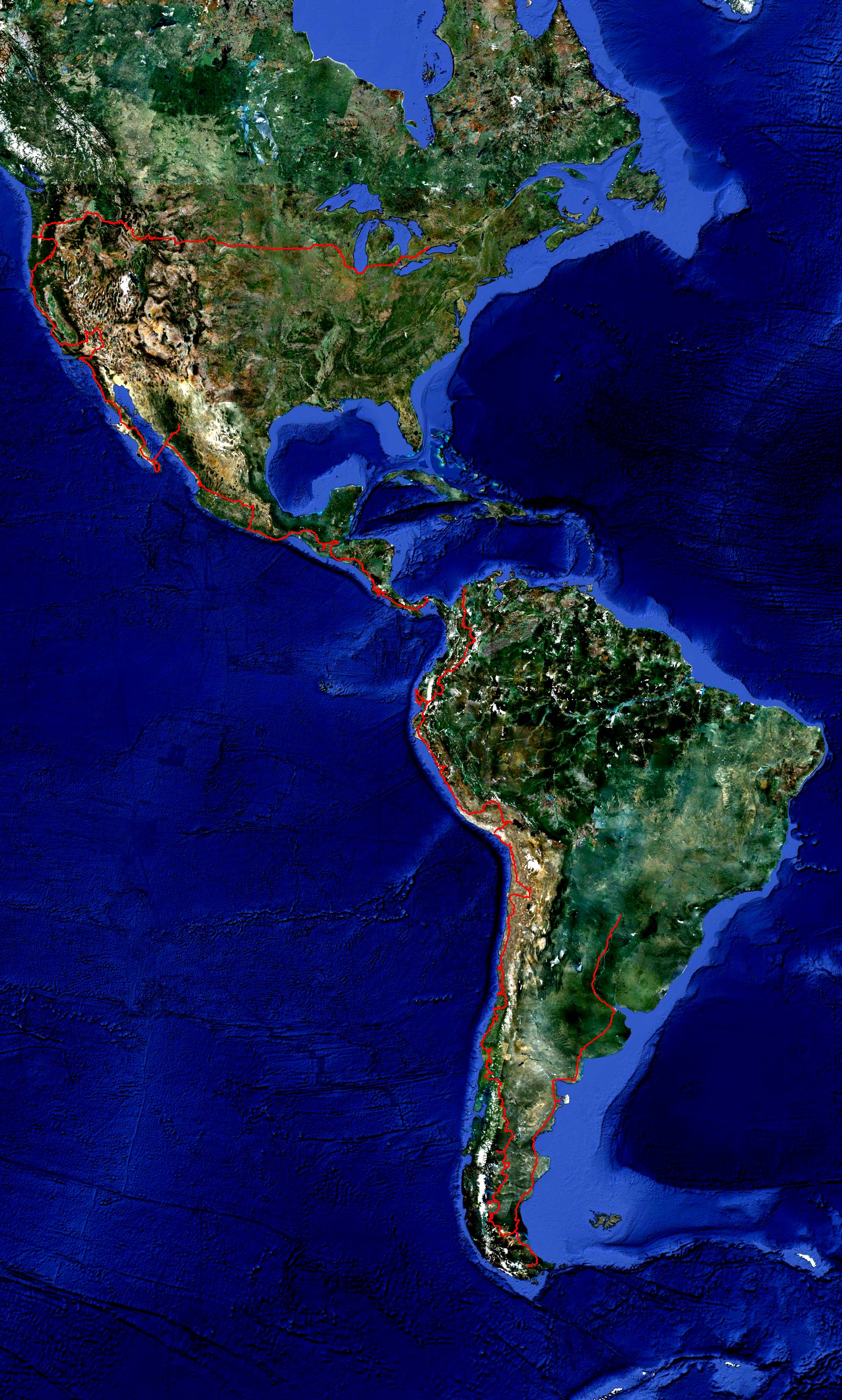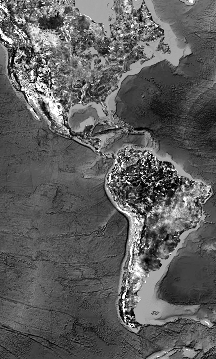After nine days of chillin and surfing on Playa El Tunco, we finally decided it was time to move on, not because we were getting bored or anything like that but because we had a trip to do. El Tunco was awesome and we were sad to leave. On the road to San Salvador, the Safari crossed the 300,000km mark still running strong and climbing up the coastal mountains towards the city…
We drove through San Salvador along the way, and then headed east along the Panamerican highway to the Honduras border crossing at El Amatillo. The highway for the most part was excellent…
We stopped by for a delicious breakfast just off the highway overlooking Lago Ilopango, a beautiful volcanic crater lake surrounded by mountains. As usual, breakfast cost $3 USD despite the beautiful setting, quality service, and delicious food…
We then hit the El Salvador/Honduras border and the fun started. Well before the border, touts who offer to help you with border formalities were already waiting and trying to flag us down. We ignored them and drove on. Canceling the vehicle importation on the El Salvador side was not a problem and was relatively efficient. We then crossed the bridge to Honduras, where it was a completely different story.
A dozen touts hoping to try to help us with documents for tips swarmed the car. For the most part we ignored them at first, but we discussed that it would probably be worth the $10 or so they wanted to help us get the documents done as quickly as possible so that we can try to cross Honduras that day and get to Nicaragua, only 125km away.
At first, an official examined our vehicle and was confused about what to do about the fact we had 4 surfboards in the car instead of the 3 that were listed on our vehicle importation permit for El Salvador. We told him we had acquired one in El Salvador but he wasn’t quite sure what to do about it and had to consult with his colleagues. When he was finally done, we were sent to make some photocopies of various documents and then proceed to another office where our vehicle permit was to be issued. Of course, the officials who issued the permits were about to go to lunch (they are always about to go to lunch), but offered to stay longer and complete our permit before they go for an additional $10. Knowing that it could take hours otherwise, we agreed to the additional $10.
The official dutifully wrote out the permit, and then asked for a $45 USD payment. However, on the permit itself an amount of 135 colons (about $6 USD) was listed rather than $45 USD. We had read online about the $45 that they demand rather than the real price of the permit, but there wasn’t much we could really do. We tried to argue about it, but weren’t able to take the discussion anywhere. Of course, we got some sort of explanation that it was a “transit fee” that is legitimate, and that we could wait and pay it at the bank on Monday (it was Saturday), or we could pay it immediately to the official in cash. After a couple minutes, the official nonchalantly said she was hungry and was going to lunch, and that we have the permit issued when she gets back. She left us in the office without our permit. Finally we agreed to pay the $45, the official was called back from “lunch” and the permit was issued. Some sort of additional $25 fee was later required to pass some sort of “inspection” which never took place. In total the border cost us about two hours and $80 to get through. Definitely the worst border experience of the trip by far.
As soon as we got past the border, we hit a country that was still in a central america of years past. Over 125km navigating some of the biggest potholes I’ve ever seen in my life (it’s hard to explain how bad this road was) we passed seven police checkpoints, at each of which we were thoroughly inspected and a number of times accused of some sort of infraction. Here’s how they went:
Incident 1
A policeman pulled us over about 5km from the border checkpoint and asked for our personal and car documents. He then asked us how much we paid at the border to receive our temporary vehicle importation permit. That was sort of a difficult question to answer since we got ripped off at the border and therefore it could be said that we “bribed” the customs agent with an unofficial payment. We said we paid 135 colons, the legal amount, but the cop understood that we had paid more. He returned our documents, and recommended that we stay away from the touts who try to help at the border.

Incident 2
The second policeman pulled us over a few km later. As the policeman approached the car, I undid my seat belt to reach for some documents. As soon as he looked in he asked why I was not wearing a seat belt and started saying how expensive the fine might be. I immediately told him his claim was incorrect as I had been wearing the seat belt until the vehicle was fully parked. He asked me to get out and talk to him behind the car. We talked about the seat belt claim and I managed to talk out of that. He then asked if I would buy him a coke or give him five dollars. I told him I cannot because I want to obey all Honduran laws and that it was illegal for me to do so under his laws, and dangerous because he could then accuse me of corrupting a cop. He took that argument and returned our documents.

Incident 3
The next checkpoint was the Honduran classic we had prepared for by buying a fire extinguisher and safety triangle. After checking that all our documents were in order, he asked for these two items mentioned. After seeing the triangle, he instructed us on its proper usage (“place to the left of the vehicle on the roadway in the event of a breakdown”, etc…) and let us go.

Incident 4
At the next checkpoint we were again asked for the orange safety triangle and fire extinguisher.

After we showed him these two items, he proceeded to inspect the rear door of the car and informed us that we needed reflective red and white safety tape on the back door, which was nonsense. I told him there was no such requirement for vehicles such as ours, and pointed out that none of the cars and pickups passing us had any reflective strips. He then pulled out a printed copy of the Honduran highway traffic law and fumbled through it looking for a law about reflective strips. He couldn’t find it and pointed at four different articles, each of which did not say we needed reflective strips (the articles referred to the requirements to have turn signals and other such standard equipment). Finally, he went to his colleague, who was able to find an article about reflective strips. Jono quickly noticed though that the articles around it did not seem to refer to passenger cars, and asked to review the book. Ewa snapped a photograph of the law book…
As Jono fumbled back through the book to check which section this article was in (if it was in the section for trucks) the cop started to get a little angry and grabbed his book back. He said photographing the law book was illegal and did not allow us to touch it again. Finally, he let us off with a promise to buy reflective tape at the nearest store and install it on our back door.
Incident 5
The next checkpoint again asked for our documents and the safety triangle. He then asked for the second safety triangle, which is nonsense because a second safety triangle is not required. We told him so, and after a minute or two of arguing over that law we told him we had checked the Honduran traffic laws before coming, bought the triangle and extinguisher to comply with them, and were confident that the latest version of the law did not require two triangles. He quickly gave up and let us go.
Incident 6
We had only one checkpoint that went smoothly. The officer reviewed our documents, found them in order, and allowed us to continue on our way.
Incident 7
By the time we got to the seventh checkpoint, we had the fire extinguisher and safety triangle in the front of the car with us to try to expedite the inspection process. Unfortunately, the fire extinguisher fill gauge was a little lower than full.

The cop accused us not having an adequately filled fire extinguisher and ordered us to go to the police station, which was at the site of the checkpoint, to discuss and pay our fine. We were outraged at this point, as this was the sixth police check in under 100km. We walked into the office and told the cop that the accusation is incorrect, and that our fire extinguisher is full and functional. We offered to demonstrate it in front of the police station. We also told him that we were transiting Honduras and about to leave in less than an hour, and finally he let us go.
Nicaragua border
When we reached the border with Nicaragua we were relieved to finally be getting out of Honduras. We had spent five hours too long in the country and were tired of police checkpoints and massive potholes. At the border, formalities to end the export of the vehicle were very straightforward. In fact, we were left with no documents even showing we’ve ever been to Honduras. They put all of them into big red plastic bags behind the customs agent, which we could only guess were going to be put into a big pile and burned at some point.
A helpful and friendly officer on the Nicaragua side of the border explained the import process in Nicaragua, which was very straightforward and smooth, and we were glad to be on our way in less than twenty minutes.
The road was much better than Honduras but there was still the odd pothole, so as night fell we stopped at the first large town, Chinandega.











































































































What a mission.
Lol. I can totally hear your voice reading this. The nerve! Ha. See you Saturday!!!
way to stay strong there… I would’ve bought the guy a coke.
Haha awesome.
Mastering foreign traffic law and manoeuvring through dubious law enforcement — check.
Great advertising for Tourism Honduras, Kuba!!